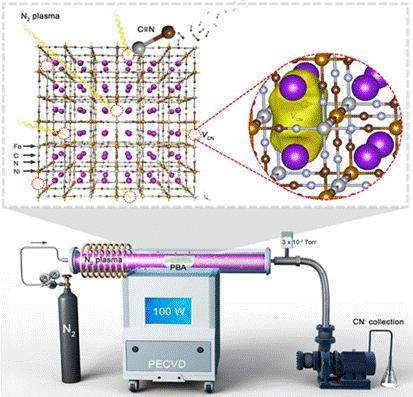| Unconventional CN vacancies suppress the leaching of iron active species for boosted oxygen evolution catalysis |
| From: PublishDate:2020-07-30 Hits: |
The improvement of the slow kinetics of the oxygen evolution reaction (OER) is extremely important for promoting the efficiency of various energy storage technologies, such as photo/electricity-driven water splitting and rechargeable metal-air batteries. Although marked advances in the development of heterogeneous catalysts to accelerate the OER, progress in real device applications still requires innovations in catalyst design for better-performing properties. Manipulating defect chemistry has been widely seen to tune the properties and functionalities of materials. In particular, vacancy defect engineering can lead to substantial structural perturbations in catalysts, with the capability to tailor surface electronegativity, charge concentration and redistribution, enabling enhanced reactivity. Creating new kind of vacancies in existing catalysts could produce catalytically active sites and provide opportunities for designing better OER catalysts, but it is still a big challenge. A research team led by Prof. Shu-Hong Yu and Prof. Min-Rui Gao from the University of Science and Technology of China (USTC) proposes a simple and effective method to create unconventional CN vacancies (VCN) in Ni-Fe Prussian blue analogue (PBA) by a nitrogen plasma bombardment process. Such VCN is largely distinct from the well-studied vacancies previously documented, which not only tunes the local electronic structure and coordination environment of the Ni-Fe sites, but also limits the loss of Fe element during OER process; these together enable a new, robust and high-performance Ni-Fe oxyhydroxide from PBA pre-catalyst during OER. This work was published on Nature Communations entitled as "Unconventional CN vacancies suppress iron-leaching in Prussian blue analogue pre-catalyst for boosted oxygen evolution catalysis" (Nature Communations 2019, 10, 2799). Researchers started with the NiMoO4 nanorods as precursors to prepare Ni-Fe PBA porous nanorods by an ion exchange process. Afterwards, VCN was formed by the direct N2 plasma bombardment. Various characterization techniques, including high-resolution transmission electron microscopy, positron annihilation spectroscopy, elemental content analysis, and the tail gas detection, have confirmed the formation of VCN (Fig. 1).
Fig. 1. Schematic illustration of the structure and preparation of VCN-mediated Ni-Fe PBA. Electrochemical tests revealed that PBA bombarded by N2 plasma for 60 minutes (PBA-60) had the best OER activity with an onset overpotential of 225 mV and an overpotential of 283 mV at 10 mA cm-2, much better than other studied catalysts (Fig. 2a, b). The high OER catalytic activity can be attributed to the coordinatively unsaturated Ni and Fe sites induced by VCN. Meanwhile, OER stability tests revealed that [Fe(CN)6]4- groups in VCN-free PBA (PBA-0) readily diffuse outward to the electrolytes during OER via anion exchange with OH- ions, causing Fe loss in the structure, whereas the unsaturated Fe site in PBA-60 can bond with oxygen to yield Fe-O bonds, preventing the Fe loss during OER, which enables the catalyst to perform very robustly for a long-term stability tests (Fig. 2c, d).
Fig.2 (a) OER polarization curves of different studied catalysts. (b) Comparison of the current densities of different catalysts at different overpotentials. (c) OER stability tests for PBA-0 and PBA-60 at 10 mA cm-2. (d) Illustrations of the surface reconstruction on the Ni-Fe PBA catalyst during OER, where the VCN suppresses of Fe loss, permitting the formation NiFeOOH surface active layer. The X-ray absorption spectra of Ni L-edges and O K-edges were obtained from Beijing Synchrotron Radiation Facility (BSRF, 4B9B beamline). The Ni L-edge results indicate that surface Ni2+ ions were partially oxidized to Ni3+ ions after the VCN formation, which suggests the electron transfer from Ni to the adjacent Fe sites. The adjacent Ni and Fe sites synergistically boost the OER activity. Moreover, the O K-edge results further confirm the formation of highly active NiFeOOH species. Researchers anticipate that the CN vacancies described here not unique to Ni-Fe PBAs, but bears general implications for other catalyst systems with CN groups. This will aid the development of newly advanced catalysts for modern energy devices, which will inspire other researchers to develop a new path for the design of better-performing OER catalysts that are low-cost and readily synthesized. This work was supported by the funding support from the National Natural Science Foundation of China, the Users with Excellence and Scientific Research Grant of Hefei Science Center of CAS, the Key Research Program of Frontier Sciences of CAS, the Fundamental Research Funds for the Central Universities, and the Recruitment Program of Global Youth Experts. Article: Zi-You Yu, Yu Duan, Jian-Dang Liu, Yu Chen, Xiao-Kang Liu, Wei Liu, Tao Ma, Yi Li, Xu-Sheng Zheng, Tao Yao, Min-Rui Gao, Jun-Fa Zhu, Bang-Jiao Ye, Shu-Hong Yu. Unconventional CN vacancies suppress iron-leaching in Prussian blue analogue pre-catalyst for boosted oxygen evolution catalysis, Nature Communications 2019, 10, 2799. |
|
|
| Chinese
- Metal-free efficient photocatalyst for stable visible water splitting——Top ten major scientific progresses in China in 2015
- The nano-resolution imaging platform was awarded the first rate prize of Beijing Science and Technology in 2014
- Beamline 1W1 of BSRF started to runoperate in the couplingparasitic mode of BEPCII
- Synthesis of High Performance Polymer Materials for Field Effect-Transistors
- Surfactant molecular aggregates in green solvents
- GIXRD has played an important role in the characterization of organic thin-film transistors
Copyright © 2011 - 2012 Beijing Synchrotron Radiation Facility



